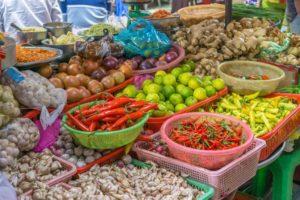Description
Locally produced food, crops and animals that are raised within a 100-mile radius of consumption, has many benefits, including dietary, environmental, and economic.
- It is healthier because it is picked at its peak and the time from farm to table is minimized.
- Reducing the distance between farm and table means less GHG emissions associated with transporting food to markets.
- Local food preserves genetic diversity because local farms are smaller and often grow different varieties of crops to provide a longer growing season.
- Livestock diversity is also a result of having many smaller farms.
- Local food protects open space because when farmers are able to market locally they are less likely to sell their land to developers.
- Since farms pay more taxes than they require in services, preserving local farms keeps taxes down.
- Buying locally keeps money circulating in local economies and supports regional economic development.
Some methods that municipalities can use to encourage consumption of locally produced food include:
- Support local farming and kitchen gardens
- Encourage residents to “buy local” and to shop at farmers markets
- Sell “Buy Local” reusable cloth bags at Farmers Markets and local grocery stores
- Encourage residents to join CSAs
- Encourage “Locally produced” indicators at stores
- Host “shop local” campaigns
- Encourage restaurants and institutions to source food locally and encourage patronage of these restaurants.
- Encourage institutions to source 25% of their food from local farms.

Implementation Phases
This action could be fully implemented today.
Challenges
- Town residents may be unaware of the benefits of buying locally produced food.
- Institutions and retailers may find it easier to buy from food service companies that source from large agribusinesses than buying from a number of farms.
- There is a lack of distribution networks for small farms.
Example Municipalities
Several municipalities have already implemented this action…
- Municipalities across the country have created FPC’s, or Food Policy Councils, to ensure that their residents can access local and healthier foods. At the beginning of the millennia, the number of municipalities with such programs was close to zero. By 2017, the number had risen to 263
- Baltimore, Maryland is a leader in promoting local agriculture including a 90% property tax credit for urban famers of five years or more, leasing city-owned farmable property to be used for agriculture for $100 a year and granting local unions benefits such as allowing their dues to be directed to local CSA’s (Community Supported Agriculture)
- Los Angeles, California built its community engagement strategy in conjunction with its Food Policy Council who’s successes include increasing the amount of fruits, vegetables and locally sourced foods served at schools
Greenhouse Gas (GHG) Reductions
Data
Average emissions by food per household: 8 tons [FOOD’S CARBON FOOTPRINT]
Number of households in Bethlehem, NY: 14485 units [Town of Bethlehem Demographic and Growth Analysis 1991-2018]
Reductions of CO2e after shifting to local foods seasonally: 7% [Eat your way to a smaller carbon footprint]
Assumption
Average emissions by food per household is 8 tons CO2e per year.
Methodology
We calculate the:
- Total emissions food produces per year.
- Total reductions of CO2e after shifting to local foods seasonally.
Result
7360 metric ton of CO2e is reduced when buying locally produced goods and food is encouraged.
This results LARGE GHG emissions reductions.

Climate Smart Communities (CSC) & Clean Energy Communities (CEC) Link
This action is also related to a CSC action for which municipalities can earn points toward certification.
CSC Actions:
- Municipals can earn 2 CSC points for development and launch of a formal public awareness campaign through CSC’s PE8 Action: Buy Local/Buy Green Campaign.

Co-benefits
There are multiple co-benefits to completing this action, including:
- Supports preservation of local farms.
- Increased availability of fresh produce and meats for businesses and residents.
- Health benefits of locally produced goods and food.
- Increase genetic diversity in crops and livestock.
- Reduced taxes for nonfarm residents.
- Increased regional economic impact and jobs associated with the “multiplier effect” of local investment.
- Reduced long-distance transportation of good and food.



